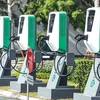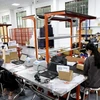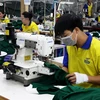The central province of Thua Thien-Hue has set up another aquatic protected area in Phu Da town, Phu Vang district, the 12th of its kind in the province.
The 12 aquatic protected areas in Thua Thien-Hue cover a combined acreage of nearly 364 ha out of the 22,000 ha of the Tam Giang-Cau Hai lagoon, which is the largest of its kind in Southeast Asia .
The establishment of such protected areas aims to preserve and develop aquatic resources in the lagoon with the involvement of the local community.
Since the beginning of the year, localities in the lagoon region have mobilised local people to release breeding fish and prawn fry into aquatic protection areas.
In addition to the establishment of community-based aquatic protected areas, the province has licensed 45 fishery association branches to catch seafood on 71 percent of water surface in the lagoon.
More than 300,000 people, or nearly 30 percent of the province’s population, live on resources from the lagoon. They harvest about 7,000 tonnes of aquatic products per year.-VNA
The 12 aquatic protected areas in Thua Thien-Hue cover a combined acreage of nearly 364 ha out of the 22,000 ha of the Tam Giang-Cau Hai lagoon, which is the largest of its kind in Southeast Asia .
The establishment of such protected areas aims to preserve and develop aquatic resources in the lagoon with the involvement of the local community.
Since the beginning of the year, localities in the lagoon region have mobilised local people to release breeding fish and prawn fry into aquatic protection areas.
In addition to the establishment of community-based aquatic protected areas, the province has licensed 45 fishery association branches to catch seafood on 71 percent of water surface in the lagoon.
More than 300,000 people, or nearly 30 percent of the province’s population, live on resources from the lagoon. They harvest about 7,000 tonnes of aquatic products per year.-VNA



















